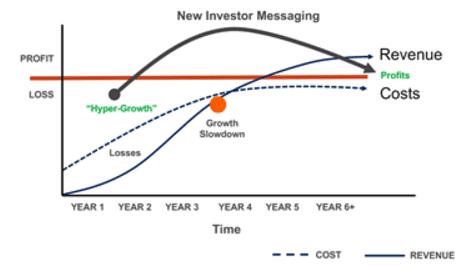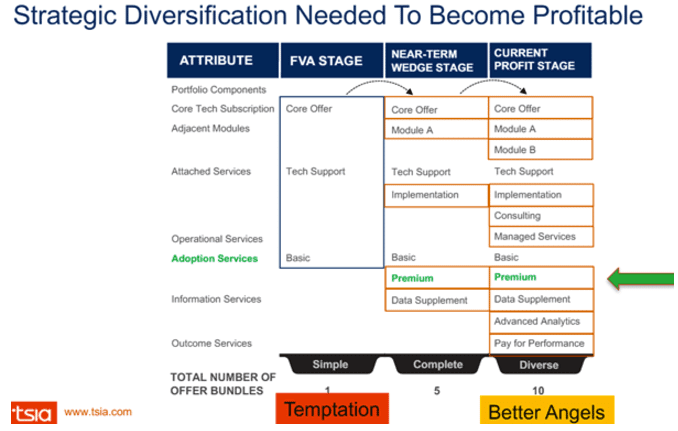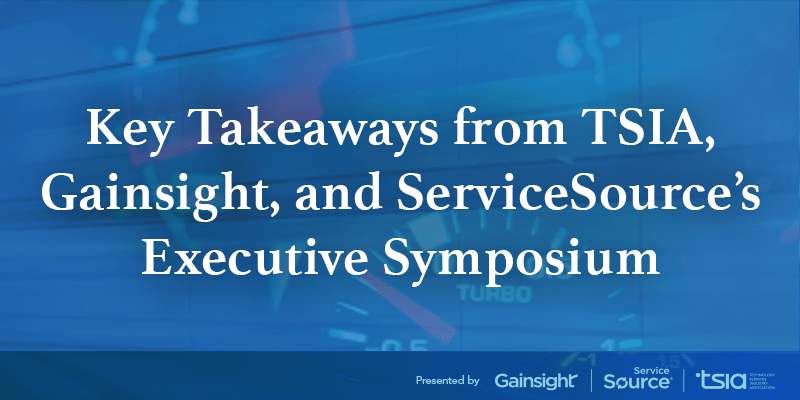What does it mean to manage a recurring-revenue business? How should functions rally around the customer? What are operational best practices? What targets should you strive for?
To answer these questions, TSIA, Gainsight, and ServiceSource came together to conduct the first Recurring Revenue Tour in Boston on April 11. This event included thought leadership presentations in front of executives from Fortune 500 and high-growth companies.
The half-day event included presentations from each of these three CEOs:

“Revenue generation is a process, not a heroic act; a set of people, process, and technology”

“Customers believe vendors treat them like an assembly line. They want a symphony—a coordinated, company-wide approach to success.”

“Customers don’t care about the drill bit; they are about the seven-inch hole”
Bookending the day was a networking lunch and a cocktail event.
Select insights from the event are below:
TSIA: What does “hell” look like for businesses? How do businesses get to “heaven?”
What does hell look like?
a) Hell can be a growth slowdown. Companies need to have a path to profitability as this is happening.

b) Hell can be the transition from a transaction-based revenue stream to a recurring revenue stream. Companies will have to invest a lot upfront in scaling the functions needed to support recurring revenues. Expenses are realized immediately, but revenues come in perpetually.

How can a business get to profitability heaven?
As businesses scale, their business models have to evolve—always in light of the eventual path to profitability.

Companies need to have a clear end-state financial model—profitable XaaS companies need to diversify revenues.
- Platform prices constantly face commoditization/downward pressure. Businesses have to monetize in other ways:
- AWS—40+ price changes in last couple years
- Oracle maintenance is an 80% gross margin business, significantly driving the profitability of the overall business


Key XaaS profit decisions live in these three areas (portfolio/pricing, customer engagement model, financial keys).

How do you achieve next-generation engagement and profitable GTM models? It’s a process, not a heroic act.

Sales reps need focus land, need data-driven platform to assist in renewal
- Need a tight triangle (relationship between sales, success, service)
- Sales shouldn’t deal with minimal upsell
- CSM, renewal specialist, or data platform should handle smaller upsells and renewals
- Only have sales handle big expansion
- Business have to trust CSMs to handle renewals

Expectations from the Customer Success team:

Profitable XaaS 2.0 P&L:

Gainsight: Vendors have to shift the perception of their lifecycle from how the customer sees it—an assembly line (passing the customer off from one function to another) to a symphony (where each function is in harmony)
As the business models change, the customer journey has changed:

In the eyes of the client, the customer journey can be give and no take:

To better “act in harmony,” businesses should adopt the following five best practices:
- Develop an accountable, actionable scorecard (a matrix between functions and indicators)
- Create a detailed, event and data-driven client journey
- Develop different strategies/engagement models for different sized customers
- Develop a coordinated, company-wide approach to customers
- Success for all—success for the vendor, the channel, and the customer—in a coordinated way
- Treat the client lifecycle like a product. Understand what works or doesn’t through AB testing/experimenting. Thorough trial and error will strengthen your delivery to the client and help you understand the best practice for your business.
- Understand the customer’s job to be done: proactive engagement, prescriptive conversations, personalized interaction
- Let data drive decision-making: get the data, analyze, act on the data
- Orient around the outcome: align internally (and externally), allocate resources for Customer Success, accept shared risk and reward






The way Bright Horizons achieved best practices through Gainsight:


ServiceSource: Bringing it back together to highlight the only thing that matters to customers: outcomes
Major economic shifts have brought significant business model changes

What customers really care about: outcomes, not the drill bit. And they actually don’t care about the hole either. What they want to buy is the outcome… They want what is enabled by the hole.

Where does your business fall on the outcome-oriented scale?

Ways to accelerate recurring revenue in the outcome economy:

Adobe made a full commitment to the outcome economy in 2012 and “burned the boats.” Market cap has increased 4x since 2012.

One example of a company transforming its business to focus on outcomes: a 70-year-old life sciences company with large installations.
Outcome desire: improved CSAT, increased revenue and warranty conversion

New processes: ServiceSource engages its end-customers from point of sale and throughout the lifecycle to ensure a seamless renewal, warranty conversion, or upsell growth outcome.

Learnings: arm field resources with new outcomes, connect CSAT to growth, understand which touchpoints are optimal, and more isn’t always better

ServiceSource’s six best practices of an outcome-oriented business:

Want one of these events in your city? Contact us at marketing@gainsight.com.
About Gainsight
Gainsight™, the leading Customer Success platform, helps businesses grow faster by reducing churn, increasing upsell, and driving customer advocacy. Gainsight’s product helps you touch customers effectively, track customer health consistently and transform the way your company orients around the customer. Gainsight provides a 360° view of customers and drives retention across Customer Success, sales, marketing, executive and product management. Learn how leading companies like Adobe, Box, DocuSign, HP, Marketo, Nutanix and Workday use Gainsight to help their customers succeed at www.gainsight.com.
About TSIA
The Technology Services Industry Association (TSIA) is the world’s leading organization dedicated to advancing the business of technology and services. Technology services organizations large and small look to TSIA for world-class business frameworks, best practices based on real-world results, detailed performance benchmarking, exceptional peer networking opportunities, and high-profile certification and awards programs. TSIA corporate members represent the world’s top technology companies as well as scores of innovative small and mid-size businesses in four major markets: enterprise IT and telecom, consumer technology, healthcare and healthcare IT, and industrial equipment and technology. TSIA’s editorial blog, Inside Technology Services, is widely recognized by technology service professionals for providing thought leadership and insights into industry trends and best practices. Visit us at www.tsia.com, follow us on Twitter @TSIACommunity, or connect with us on LinkedIn and Google+.
About ServiceSource
ServiceSource (NASDAQ:SREV) is a global leader in providing outsourced, performance-based revenue growth and customer success outcomes. ServiceSource’s Revenue-as-a-Service platform is designed to measurably accelerate customer ROI by helping companies to more efficiently and effectively find, convert, grow and retain their B2B customer relationships. Trusted by more than 65 global market leaders in the cloud/XaaS, software, technology hardware, healthcare & life sciences and industrial sectors, ServiceSource sells, manages or renews $9+ billion of revenue annually on behalf of its clients. By leveraging a robust technology suite, predictive data models and more than 3,000 revenue delivery professionals, only ServiceSource brings to market over 15 years of expertise and the ability to drive recurring revenue growth in 35 languages to more than 170 countries. To learn more, visit www.servicesource.com.


